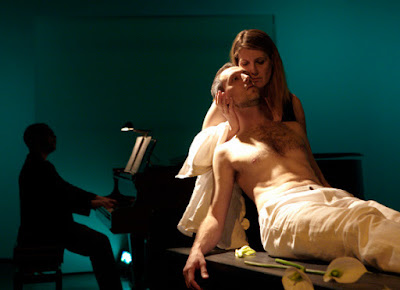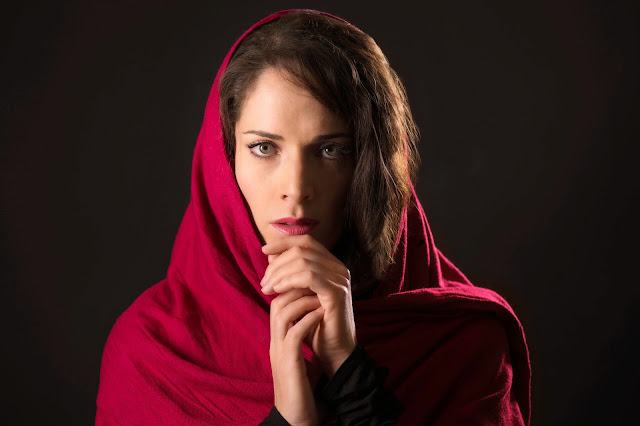| Peggy Kriha Dye as Armide. Photo by Bruce Zinger. |
Happy endings don’t always happen; happy endings can’t always happen. Happy endings shouldn’t always happen.
These thoughts ran through my mind driving home Thursday evening after seeing Opera Atelier’s sumptuous Armide, directed by co-Artistic Director Marshall Pynkoski. A tragic love story with great outfits and delicate court dancing, the 1686 Lully work, while highly mannered and fantastical, has many rich opportunities for deep emotion and gripping drama. As the Globe and Mail’s Robert Harris writes, Baroque opera “was and is a fascinating amalgam of ballet, drama, comedy, luscious costumes, extravagant sets and an overall dedication to theatrical opulence.” Opera Atelier, dedicated to preserving the art and integrity of the form, lovingly caters to each and every element with scintillating detail.
Set during the First Crusade, Armide (Peggy Kriha Dye), a powerful Muslim warrior-priestess partially modelled on Homer’s Circe, traps Renaud (Colin Ainsworth), a Christian knight; she knows she should kill him, but finds she can’t because she’s developed feelings. So she casts a spell that makes him love her back (and one that would make it much easier to murder him, since she recognizes her equal in a combative sense) — but she remains haunted by the fact Renaud’s love isn’t real, and she moves between wallowing in feelings, and swallowing them. Though she calls on Hatred (Daniel Belcher) to assist her in erasing her feelings, it doesn’t work. Before she can return to her beloved, two of Renaud’s soldiers, Chevalier Danois (Aaron Ferguson) and Chevalier Ubalde (Olivier LaQuerre) appear and break Armide’s spell. Renaud prepares to leave, but not before Armide returns and begs him to stay or take her with him; he refuses and departs, and Armide is left alone.
| Peggy Kriha Dye as Armide and Colin Ainsworth as Renaud. Photo by Bruce Zinger. |
There is a recognizably Eurocentric idea at work in the opera which immediately bring to mind Said’s writings on Orientalism. Lully and librettist Philippe Quinault cast their sights on the world of the near East and its perceived exoticism by Europeans, with the opera’s story based on a tale contained within 16th century writer Torquato Tasso’s poem La Gerusalemme liberata (Jerusalem Delivered); I recently saw another (shorter) opera by Monteverdi based on the same work, Il combattimento di Tancredi e Clorinda (The Battle of Tancredi and Clorinda) at the Canadian Opera Company, with all the Orientalist nonsense firmly set aside. (It can indeed be done!) In that work, as in Armide, there is a horrible cloud of despair hanging above the would-be lovers. The idea of different cultures coming together awkwardly, clashing, melding, and clashing again runs like a fine (if hard) gold thread throughout Lully’s work; it’s as if the realities of the outer world — outside of magic and other fantastical situations — are too difficult to be surmounted.
That’s awfully gloomy, but somehow, sadly precise, because it’s a tacit acknowledgement of the harsh geopolitical situations that prevent so much true understanding between cultures, not to mention the deep sociocultural chasms that exist between men and women. Though Tasso’s work ends with its dubious heroines converting to Christianity (surely a mark of the Europe in which it was written, one that perhaps hasn’t changed much), it’s interesting Quinault felt the need to end the opera where he did, with Renaud’s departure and Armide’s devastation.
 |
| Peggy Kriha Dye (Armide) and Tyler Gledhill (Love). Photo by Bruce Zinger. |
So of course, the soldier-sorceress has no happy ending. Why would she? How could she? Not only would Tasso’s 16th century never allow it, but a picture-perfect ending would be too saccharine, and frankly disingenuous to the overall sour tone of the piece. Sure, there is the comedic relief of the soldiers (Ferguson and LaQuerre make an immensely likeable pair onstage, channeling Laurel-and-Hardy-style buddy humor) and the lovely dancing of the Atelier Ballet (choreographed by co-Artistic Director Jeannette Lajeunesse Zingg); there is also the winged presence of Love (Tyler Gledhill), a stretching, leaping, embracing figure who silently entreats the titular magician to follow a softer path.
But, ultimately, as the final notes sound and designer Gerard Gauci’s set reveals hotly-colored flames surrounding a solo Armide, we know the butter-soft visuals and languid scenes of romance that have gone before are a ruse; Lully’s music has darkness in buckets, and it’s the perfect complement to Philippe Quinault’s libretto and Tasso’s wrenching poem. More cynical (or perhaps over-romantic) types would argue the ending can’t be good: Armide is alone and devastated, and she has to live with a love that can never be satisfied or consummated. But there’s a strange freedom in that isolation. Keeping her power (limited as it may be) and sense of independence within the borders of her homeland, close to family and trusted peers feels like a better (less exciting, probably more adult) option than traveling to another country and a culture that would undoubtedly be hostile toward and ultimately reject her, or keeping her lover in a land where he might experience the same treatment.
 |
| Colin Ainsworth (Renaud) and Peggy Kriha Dye (Armide). Photo by Bruce Zinger |
What’s more, keeping Renaud in a haze of love isn’t love at all — it’s manipulation, a nasty form of control, domination, and possessiveness, behavior that surely drives love (the real kind) away very quickly. Besides, there’s something strangely satisfying about the woman not getting the man at the end and living happily ever after, and about the disruption to the cliched princess fairytale that too often dominates cultural depictions around women and love.
Armide still lives in love at the end, just not with a love that is incarnated within the physical form of Renaud. The ending strips away the bullshit romance aspects of the story to reveal something far more interesting and human: vulnerability. That quality is precisely what powers this production, and indeed, so much great art. Staring at the abyss and letting the world see our raw, naked, true selves is frightening — even moreso when we have to do it alone. But do it we must. The question is, will we move forwards, vulnerable and exposed, in love, or in hate?











